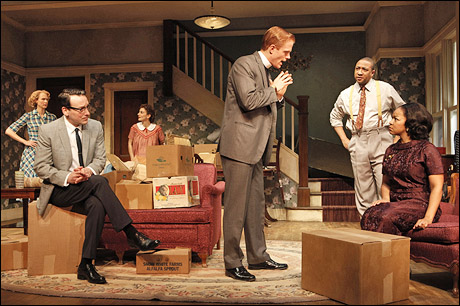In today’s Wall Street Journal I have nothing very good to say about the Broadway transfer of Bruce Norris’ Clybourne Park. Here’s an excerpt.
* * *
It happens that I was on the road throughout the Off-Broadway run of “Clybourne Park,” and ever since then I’ve been wondering what I missed. Was it really possible that a playwright had finally gotten up the nerve to take an unsparingly honest look at race relations in America? Stranger things have happened–but not this time around. “Clybourne Park” turns out to be a runny egg, a play that pretends to be daring but takes the utmost care not to be too challenging to the assumptions of its viewers.
 As you probably know by now, Mr. Norris’ play is a variation on “A Raisin in the Sun,” Lorraine Hansberry’s 1959 play about the Youngers, a black family that moves to a white neighborhood in Chicago. In the first act of “Clybourne Park,” set in 1959, we meet Bev and Russ (Christina Kirk and Frank Wood), who are selling their house to the Youngers (who are talked about but never seen). Also present and very much accounted for are their black maid (Crystal A. Dickinson), her husband (Damon Gupton), and a group of outraged neighbors who all claim to be good liberals but draw the line at living next door to blacks: “Who shall we invite next, the Red Chinese?”
As you probably know by now, Mr. Norris’ play is a variation on “A Raisin in the Sun,” Lorraine Hansberry’s 1959 play about the Youngers, a black family that moves to a white neighborhood in Chicago. In the first act of “Clybourne Park,” set in 1959, we meet Bev and Russ (Christina Kirk and Frank Wood), who are selling their house to the Youngers (who are talked about but never seen). Also present and very much accounted for are their black maid (Crystal A. Dickinson), her husband (Damon Gupton), and a group of outraged neighbors who all claim to be good liberals but draw the line at living next door to blacks: “Who shall we invite next, the Red Chinese?”
The second act flashes forward to the same house a half-century later. Sure enough, white flight turned Clybourne Park into a crime-ridden ghetto, but one that has since been transformed yet again, this time by the equally inexorable forces of gentrification. Enter Lindsey and Steve (Annie Parisse and Jeremy Shamos), a well-heeled young white couple who want to buy the Younger house and turn it into something bigger, fancier and tackier. This displeases Kevin and Lena (Mr. Gupton and Ms. Dickinson), a buppie couple who are worried about the effect that such a renovation would have on the “historical value” of the neighborhood. What follows is a “God of Carnage”-style free-for-all in which we discover that Lindsey and Steve are just as racially insensitive, albeit in a more genteel way, as their forebears.
What makes the success of “Clybourne Park” so interesting is that American theater is a monoculture, a thick-walled bubble in which you’ll look long and hard to find anyone with an opinion about anything that is anywhere other than well to the left of center. The trouble with monocultures, of course, is that they tend not to encourage self-criticism. Hence it’s always encouraging whenever a playwright dares to take shots at his own side. The bad news is that the comedy in “Clybourne Park” amounts to little more than lazy caricature. This is especially evident in the first act, which is peopled with vapid stick figures who appear to be drawn not from real life but from an Eisenhower-era TV sitcom. If that’s Mr. Norris’ idea of satire, he needs to sharpen his pencil….
* * *
Read the whole thing here.
Terry Teachout on the arts in New York City
An ArtsJournal Blog
